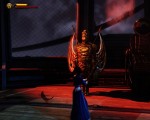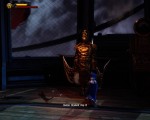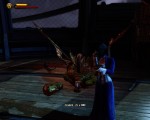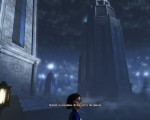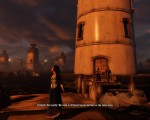In which we kill a prophet, defend a tower and kill another prophet.
And the end of this post I’ll sum up and explain do something to the ending that may or may not resemble an explanation. Therefore this post gets an additional spoiler warning.
We’re now on the uppermost level of Comstock’s private airship. There’s a model of Monument Islands monument here, complete with Elisabeth’s chamber and the syphon. Guess who didn’t take a picture? Right you are.
On our way here, Comstock made one last announcement via the PA: Time will flow backwards before DeWitt finds redemption, as some sins cannot be forgiven. Knowing how right he will be would probably surprise him…
Moving forward, we finally meet the old man in his private chapel. Upon entering the chamber, Booker wants to go in before Elisabeth to finish Comstock, but she goes in first saying that this is between him and her.
The game takes our guns away, because shooting during a scripted event is verboten.
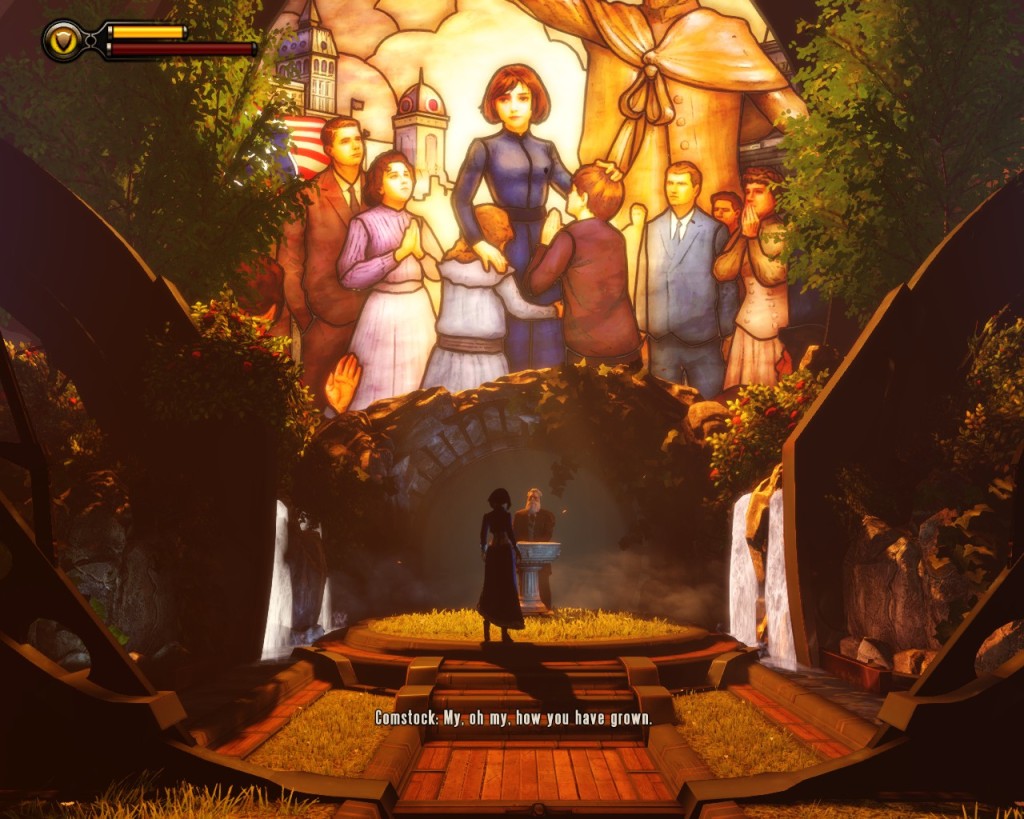 Once more I understand the reason for grabbing my guns and forbidding me to just gun Comstock down. This is an important scene, and it’s done well. I still don’t like it.
Once more I understand the reason for grabbing my guns and forbidding me to just gun Comstock down. This is an important scene, and it’s done well. I still don’t like it.
In the now following monologue Comstock scolds Elisabeth for her behaviour – after all, everything he has done was done to keep her safe. He also tells us that the archangel who revealed the whole “set ablaze the Sodom below”-story to him also warned him of the false prophet, who will be a wall between Elisabeth and her destiny.
And he says that he set heaven and hell in motion to keep DeWitt away from her, when all he had to do was to tell her the truth – she just has to ask Booker about her finger. [Elisabeth has a crippled finger. She brings this up once, on the transition to Mr. Fink’s (of Fink Mfg) Workers’ Hell.]
While talking, he proceeds to baptise Elisabeth, who struggles against him. This is where we intervene. DeWitt has lots of anger bottled-up, and all gets loose now. He starts wrestling Comstock (we still have perfectly good weapons in our pockets), bashes his head repeatedly against the font and finally drowns him in it. It’s yet another well executed scene (as I’ve said before), even if the only thing for us to do is pressing a button. The “press the button to attack Comstock”-mechanic isn’t very good. No agency at all, a fully scripted scene, would have been worse. Which reminds me to go back there and see what happens if we don’t do anything…
…I can’t. I can jump in before the last shooting before meeting Comstock or after he’s finished. I’m almost certain that we don’t get an alternative outcome here. Feel free to correct me.
After taking Comstock out of the picture, we move on to the command deck. Here Elisabeth finally gets the meaning of the cage of the note from… the other Elisabeth. The old one. C-A-G-E are the notes necessary to control songbird. She takes apart the nearby control statue to get the whistler out of it. Booker plays the tune, and Songbird is now on out side.
Up next: the final battle. It’s an awfully videogame-y moment. We have to defend the power core of the Hand of the Prophet, conveniently located outside on the upper deck, from a last attack by the Vox. Apparently this power core powers the quantum levitation Lutece field video game magic that keeps this thing afloat. This is shooty times at its finest, but at least you can order songbird to attack.
When all is over, we meet Elisabeth at the bow. Below us lies Columbia, burning. To our right, the remnants of Monument Island.
Monument Island still holds the syphon which blocks her from creating new rifts, so it has to go. We use songbird to take care of it, but lose the whistler in the process.
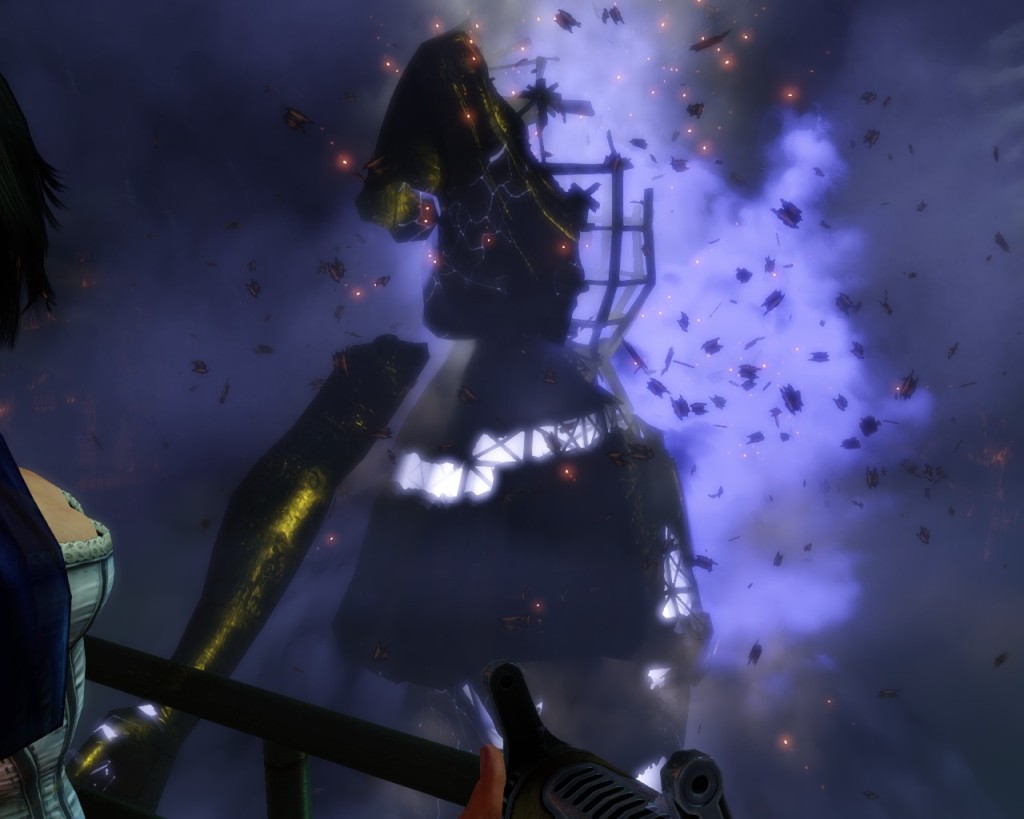 Which is bad, as Songbird, the watcher controlled by melodies, notices that we no longer hold his chain and attacks immediately. Yes, this doesn’t make sense.
Which is bad, as Songbird, the watcher controlled by melodies, notices that we no longer hold his chain and attacks immediately. Yes, this doesn’t make sense.
But as the syphon is now very much offline, Elisabeth now can open tears freely.
We’re now in Rapture, the famous City-under-the-Sea from the original BioShock and its not-that-great successor. Songbird is with us – outside the window, and he doesn’t take the pressure too well. I’ve got a feeling how the Burial at Sea-DLC got to its name…
We take a bell to the surface. During the mandatory sightseeing, Booker – the man who just left a flying city – calls the idea of a city beneath the waves ridiculous. This ignorant bastard.
What follows next is the unraveling of the whole multiverse-story.
Elisabeth understands that while there are millions and millions of worlds in this sea of doors, all have things in common. There’s always a man, always a lighthouse, always a city. And there are things that are different. Other paths taken. Constants, and variables.
So, what happened and why does it all makes sense?
Booker DeWitt and Zachary Hale Comstock are the same person.
After the battle at Wounded Knee, DeWitt was stricken with guilt over what happened there. He attempted to seek redemption in baptism. In one world he went through with it, accepting the name of Zachary Hale Comstock, in another he didn’t.
Subsequently, Comstock met Rosalind Lutece, who just made her breakthrough in applied plot magic. Together they went on building Columbia. When Lutece showed Comstock the tears, the prophecies as he saw them, he glimpsed the fire raining onto New York – fire brought by the hands of his daughter. The big problem: Comstock is sterile, so he could get his wife pregnant, so he couldn’t get the daughter he needed so desperately.
The unbaptized DeWitt on the other hand, unable to cope with his guilt, turned towards alcohol and gambling, amassing debt. He also somehow managed to get a daughter, Anna.
The Lutece-siblings (after their reunion (is that a word?)) found out and told Comstock about this. Comstock, seeing a way to fulfill the prophecy, sent Lutece to offer DeWitt something: give us the girl and wipe away the debt. In selling his own daughter to Comstock he could wipe out all his debts – the material ones, that is. He took the offer.
Then he realised what he just did and went on to get his daughter back. He was too late, Lutece and Comstock went through a tear back in their own reality, but Elisabeth lost a part of her finger – the Lutece theorise that this is the reason why she can open tears so easily: she already exists over multiple probability spaces.
DeWitt, now dealing with even more guilt, brands himself with his daughters initials, AD, on his hand. This is how Comstock could point him out as the false prophet at the beginning of the game.
Over the years, Robert Lutece comes to the conclusion that what they did was wrong and what they set in motion even more so. He talks his sister into taking DeWitt over to Comstock’s world, and even though she isn’t fully convinced she helps him.
They drag DeWitt over, and DeWitt rebuilds his memories according to this world – he still is in debt and has to get the girl for a client in New York. He enters the lighthouse.
In the Sea of Doors, DeWitt tells us that he wants to go back in time to kill Comstock before he can become the man he was. He wants to smother him in the crib. Naturally, this leads him back to his own baptism, where he is confronted by Elisabeths from all over the probability space.
“He’s Zachary Hale Comstock.” – “He’s Booker DeWitt.” – “He’s both.”
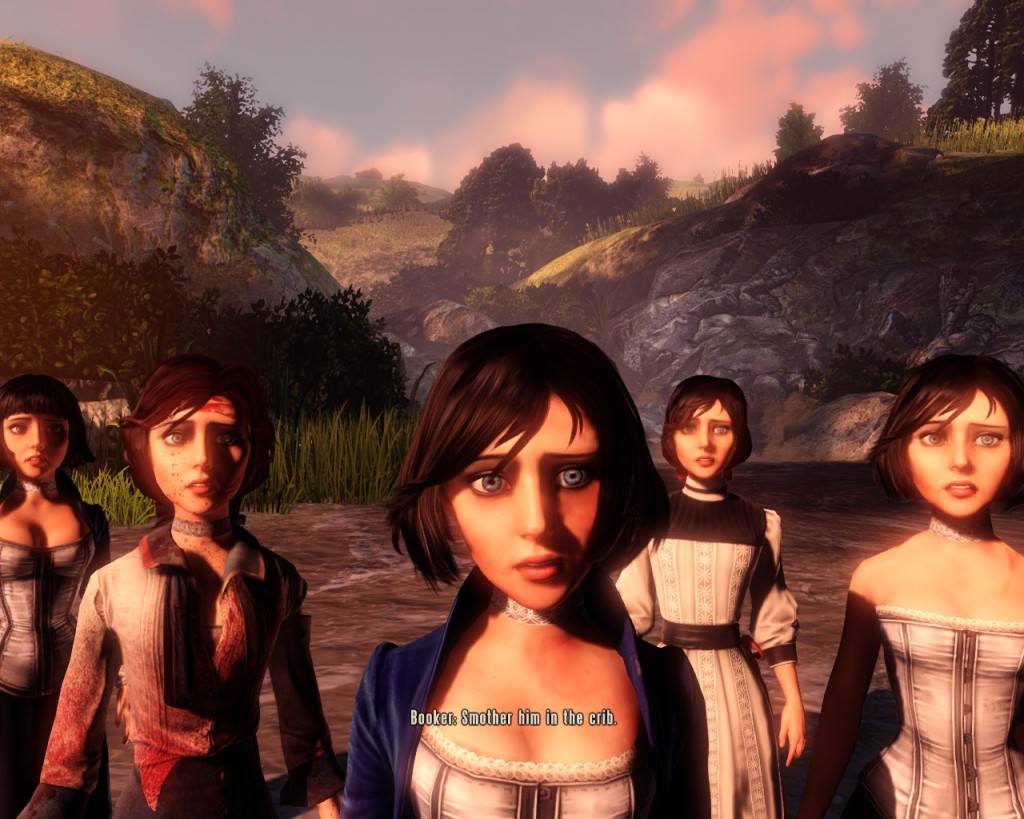 The girls drown him and fade out of existence, one after another.
The girls drown him and fade out of existence, one after another.
After the credits, we are back in Booker’s flat in New York, where he realises that is daughter lies in her crib in the next room.
This was a recollection of the events in a more or less logical way. Naturally, it doesn’t do the events as they happened within the final part of the game much good.
The ending of BioShock Infinite is well written, well executed and a rare case in which a multiverse-story is brought to a working conclusion without a liberal application of additional plot magic.
There will be a final post to wrap this up, and then we’re done.

